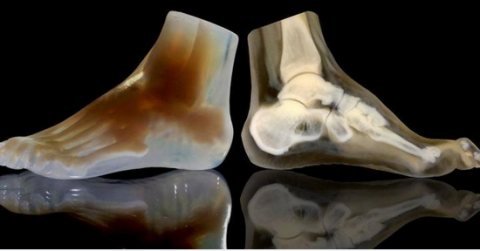Researcher’s Own Brain Tumor Inspires New Way to Model Patient Data for 3D Printing
Researchers at MIT and Harvard have collaborated on a process for creating complex and accurate 3D models of the human brain and other organs, parts, and systems in the human body for enhanced patient data.
Inspired by his own medical situation, a researcher at MIT led a team that’s developed a new method for rapidly creating accurate 3D models of organs and systems in the human body for printing. Steven Keating had a baseball-sized tumor removed from his brain a couple of years ago while he was a graduate student in the MIT Media Lab’s Mediated Matter group. Inspired by the curiosity to see how his brain appeared before the tumor was removed—and to get a better grasp of his diagnosis and treatment—he collected his medical data and began 3D printing MRI and CT scans.
Faced with time and accuracy challenges, he sought collaborative help from some members of the Wyss Institute at Harvard University, who already were exploring a new method for 3D printing biological samples. Researchers there said they hadn’t considered using their approach for human anatomy until Keating reached out to them with his problem.
The result of the collaboration is a new technique that allows images from MRI, CT, and other medical scans to be easily and quickly converted into physical models with detail that is unprecedented in any other technology until now, researchers said. The research could make 3D printing more available to medical professionals as a tool of their trade, they stated in a Wyss Institute press release.
The technology “creates exquisitely detailed 3D-printed medical models with a fraction of the manual labor currently required, making 3D printing more accessible to the medical field as a tool for research and diagnosis,” explained Beth Ripley, a medical doctor and assistant professor of radiology at the
University of Washington and clinical radiologist at the Seattle VA Medical Center, in the Wyss Institute press release. Ripley is a co-author on a paper the team published about its work in the journal 3D Printing and Additive Manufacturing.
MRIs and CT scans can produce high-resolution images, presenting them as a series of “slices” that reveal the details of structures inside the human body. In this way, they have become an integral part of physicians’ and other clinicians’ ability to evaluate and diagnose medical conditions.
However, there is a problem with providing so much detail, as it means that the subject or subjects of interest must be isolated from surrounding tissue and converted into surface meshes to be 3D printed. This is currently done with a time-intensive process called segmentation. A radiologist, for example, may have to manually trace the desired object on every single image slice, which can sometimes include hundreds of images for a single sample, researchers said in the release.





